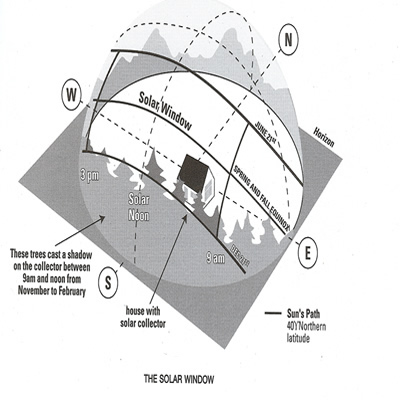





1.5Kwp Suntech Array using SMA 1200 inverter, Smethwick, West Midlands
Solar Energy
Solar energy is a combination of the hours of sunlight you can expect at your site and the strength of the sunlight you can expect. This varies depending on the time of year and the position of the earth relative to the sun.
The term for solar radiation striking a surface at a particular time and place is insolation. When described as power it is usually expressed as watts per square meter and usually presented as an average daily value for each month. Please look at the insolation data for Aberystwth:
Insolation Data for Aberystwyth:
Jan |
Feb |
Mar |
Apr |
May |
June |
July |
August |
Sept |
Oct |
Nov |
Dec |
0.78 |
1.46 |
2.57 |
4.09 |
5.35 |
5.4 |
5.19 |
4.45 |
3.17 |
1.79 |
0.92 |
0.57 |
Data courtesy of Solar Electrcity Handbook Michael Boxwell
With this information it is very easy to calculate the daily or monthly power of a given array i.e 1.666Kwp array, typical daily array output in June would be:
1666w x 5.4 = 8.9Kwh
This irradiance data also high lights the big difference between the amounts of energy available in the middle of summer as opposed to the middle of winter.
Sun Path
The path of the sun across the sky changes throughout the year. Each year there are two days in the year when the day is exactly 12 hours long:
- 21st March and 21st September (Solar Equinoxes)-Sun rises due east of the equator and sets due west of the equator. At solar noon on the equinox (6hrs after sun rise) the angle of the sun is 90° minus the local latitude.
In the Northern Hemisphere:
- longest day of the year is the 21st June (Summer solstice)- the angle of the sun is 23.5° higher than on the equinox. This phenomena is caused by the tilt of the earth, in this instance the North Pole is tilted towards the sun
- shortest day is the 21st December (Winter Solstice)-the angle of the sun is 23.5° lower than on the equinox. This is the opposite to the above i.e. the North Pole is tilted away from the sun.
Optimum Orientation of Collector
The sun’s apparent location east and west of true South is called azimuth, which is measured in degrees East or West of true South. Magnetic South is not the same as true South. The deviation of magnetic South from true South is called magnetic declination.
Daily performance will be optimised if fixed mounted collectors are faced true South or 0 degrees azimuth. An array that deviates 30 degrees from true South will collect a lesser percentage of the sun’s available energy on an average daily basis.
Tilt angle of Collector
The sun’s height above the horizon is called altitude which is measured in degrees above the horizon. When the sun appears to be just rising or just setting, its altitude is 0 degrees. When the sun is true South in the sky at 0 degrees azimuth, it will be at its highest altitude for that day. This is called solar noon.
A locations latitude determines how high the sun appears above the horizon at solar noon throughout the year. As a result of the earth’s orbit around the sun with a tilted axis, the sun is at different altitudes above the horizon at solar noon throughout the year.
Photo Voltaic arrays work best when the sun's rays shine perpendicular to the cell.
When the cells are directly facing the sun in both azimuth and altitude, the angle of incidence is 'normal'. The graph bellow illustrates the effect of this tilt angle on available insolation.

Seasonal changes of the sun's altitude must be considered to optimise a systems performance, the optimum tilt angle for a photo voltaic array for different seasonal loads is indicated in the table below:
| Load | Tilt |
|---|---|
| Year round loads | Tilt angle equals latitude |
| Winter loads | Tilt angle equals latitude plus 15 degrees |
| Summer loads | Tilt angle equals latitude minus 15 degrees. |
Solar Window
As a general rule, an array should be free from shade from 09.00Hrs-15.00Hrs on any day. This optimum collection timeframe is called the solar window.

Images courtesy of Photovoltaics Design and Installation Manual Solar Energy International
